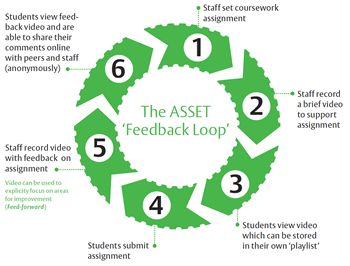How the ASSET resource worked
The 'Feedback Loop'
 What is feed-forward?
What is feed-forward?
ASSET worked by enabling staff to quickly and easily upload video/audio materials into their own module areas within the ASSET resource; videos were created using a variety of equipment, such as webcams or flip video cameras. Students registered on those modules could then access these materials from any PC or laptop and if they wished, copy their favourite video/audio clips into their own customisable 'playlists' to revisit as and when they chose. Staff could also produce short generic videos for quick upload onto ASSET. These could contain information that didn't relate to specific modules/assignments but were likely to be useful to a wide range of students. These could include titles such as 'Pitfalls to avoid when designing a poster' etc.
'Screen capture' software, such as Camstudio or Camtasia , was also compatible with the ASSET resource. This allowed staff to record what they did on their computer screen, along with their comments, in the same way they could if they had a video camera pointed at the screen. The recording could then be saved as a video file and uploaded on to ASSET for students to view. This could be extremely useful to staff who would like to use a visual means of demonstrating a point or issue on a piece of coursework.
